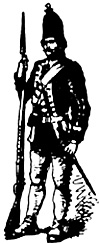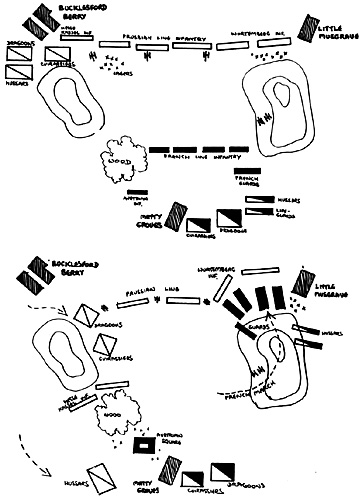 This was a battle in which my new system of written
orders worked very effectively. Basically, the method is that
instead of writing orders for all units each move, the general
gives orders to his =nits at the start of the game for as many
moves as he thinks fit, usually as many as he can plan ahead for.
This was a battle in which my new system of written
orders worked very effectively. Basically, the method is that
instead of writing orders for all units each move, the general
gives orders to his =nits at the start of the game for as many
moves as he thinks fit, usually as many as he can plan ahead for.
Thus unit "All might be told "Advance directly forward for first 3 moves till you rea~ch such-and-such a position. Then remain stationary till further orders".
So unit "All would do precisely this. Regardless of other events the unit would march straight forward; if enemy troops block the way, the unit will march against them and still try to carry out its orders. If the situation changes and the general later wishes to recall the unit or otherwise change its orders he can do the following:
- 1) Ride to the unit himself and givoorders.
2) Send an aide with fresh orders.
3) Throw an "initiative" dice. A 5 or 6 means the unit's colonel has the brUinS to rewrite his orders.
The same choices apply when a unit has run out of orders or for some reason cannot carry out orders. The only thing that can be ordered each move is what formation the unit is in, and which way it is facing.
A game played with this system has the following characteristics:
The first few moves are fast and smooth running, as most of the orders are prewritten; a commander outwitted by his opponent cannot immediately rectify the situation but must suffer the penalty of having to send aides all over the place t" t,ive fresh orders; the C-in-C failures do not spend all their time dashing along the front line encouraging their troops but are more usually found with the reserve troops, waiting to give instant orders for the commitment of these forces, the moment the critical moment of the battle arrives. Above all, battles tend to be more restrained and orderly, with battalions kept in ordered lines, as there is little opportunity for individual units to go charging off on their own at a moment's notice.
It all sounds terribly complicated but is really very simple and really puts the atmosphere in a game. I think if I tried a game now with move-by-move orders it would seem extremely dull and artificial.
 This affair took place some time between 1740 and 1765, somewhere in Europe. For reasons best known to themselves a Franco-Austrian army and a Prussian-German army came face-to-face near the village of Bucklesford Berry and decided to settle their political differences with a battle.
This affair took place some time between 1740 and 1765, somewhere in Europe. For reasons best known to themselves a Franco-Austrian army and a Prussian-German army came face-to-face near the village of Bucklesford Berry and decided to settle their political differences with a battle.
The plan shows how the forces were laid out initially.
French/Austrians
Commanded by the "Duc d'Orleanall (Chris Beaumont) and consisting of one Austrian line battalion, four French line battalions, and one battalion of the French Guards. Cavalry: two squadrons each of dragoons and cuirassiers, and on . each of hussars and French life guards. Four companies of jaegers and two batteries of artillery completed the force.
Prussians
Six battalions of line infantry, two of these from Wurtemberg, one from Hesse- Kassel, and three from Prussia. Two squadrons each of cuirassiers, dragoons and hussars; also three artillery batteries and four companies of jaegrs. Commanded by "Prinz Ludwig" (Phil Todd) .
Prinz Ludwig laid out his army in a simple line, with his guns dispersed between his battalions along the length of his front, and his cavalry and light troops :n the right flank. He intended that his centre and left would remain stationary while his strong right swept forward over the hill to seize the wood and crush the FrancoAustrian left. Thus, when the battle opened the only movement in his force was on his right.
When the Duc d'Orleans saw how the enemy artillery was ranged in front of him he instantly realised that the straight attack he had contemplated against the enemy centre would never work. He resolved upon a bold march over the hill to throw all his weight upon the German left where the artillery would not be able to play on his battalions so well. The German general watched in surprise as the five French battalions swung into column and set off up the hill behind the French artillery, which was getting the worst of a duel with the Prussian guns.
The German light infantry advanced against the Austrian jaegers in the wood and skirmished with them for a while, but the line infantry following behind being unable to penetrate the wood, had to march round. 'The Death's Head Hussars swept round behind the wood, hoping to take the Austrian battalion in rear, but faced with a solid looking square they shied off, as they had no orders to risk frontal attacks; they contented themselves with choppinE up Austrian light troops running defeated from the wood.
The main events of the contest, however, were taking place on the German left. Prinz Ludwig, who happened to have placed himself on this wing, with the Wurtemberg battalions, was cursing himself for not having formed a reserve, as the whole of the French infantry prepared to attack down the hill. However, Orleans, the architect of this skilful concentration of force, also had worries, for a small group of Hessian jaegers were hanging about the flank of his infantry and picking off men as the troops advanced. The French general called on the cavalry units nearest to him, the hussars and the Life Guards, and led them against the skirmishers, who quickly withdrew into the village of Little Musgrave, where the cavalry could not reach them, and from where they picked off a good many hussars.
The infantry attack was launched, but, encouraged by the presence of Prinz Ludwig himself, the two Wurtemberg battalions fought with remarkable strength, and though outnumbered two to one they fell back gradually but retained their order. Ludwig did not think they could hold on much longer, and when they broke the battle would be lost for him, so he desperately called for troops from the centre and right to come up and bolster the defence.
However worried Ludwig might be, Orleans shared his feelings. He, too, knew that the Wurtembergers were on the point of breaking, but, unwilling to commit his reserve too rashly he had not brought up any cavalry with his infantry. Now a couple of squadrons thrown against the Wurtembergers would have smashed them, but he had none; all his cuirassiers and dragoons were still neatly drawn up in the centre, and their brigadier wasn't sending a single squadron to help (shades of Minden!). Orleans realised too late that he should have stayed back with the cavalry ready to order them forward the moment they were needed, and now, rather belatedly, he galloped back towards them to call them to the attack.
Around the wood a confused little action worked itself out. German line and light infantry tumbled the Austrian jagers out of the woods and the hussars careened along hacking down fugitives. However, scattering Austrians took shelter around the line infantry square and the hussars ran headlong into this formation of infantry. Being constricted between the wood and the village, the cavalry were in a dense mass and actually drove the line infantry back.
Again and again the French infantry hurled themselves on to the piecemeal line of durtemberg troops, but even the French Guards could make no headway as Ludwig managed to rush up a battalion of Prussians from the centre to strengthen the line, and turned some of his artillery to face the attack. Too late, Orleans led the cavalry forward; his infantry were by then withdrawing, spent and shattered, over the hill and so he halted his cavalry and called a retreat.
CONCLUSIONS
Orleans had conceived a great plan which outwitted his opponent, but failed in executing it, in that he should have sent a strong cavalry force with the initial attack to exploit immediately the infantry success.
Prinz Ludwig shouid have had a reserve at hand. Had there been a unit free to support his overwhelmed flank from the start Orleans' move would have been foiled. Ls it went, Ludwig was saved only by the courage of the Wurtembergers (some good dice there) in holding the French onslaught. Ludwig's own attack around the wood might have worked rather more smoothly had he known at the start that his line infantry could not march through the wood; in future he will have a quick look at the rules before he draws up a plan of attack!
Back to Table of Contents -- Wargamer's Newsletter # 105
To Wargamer's Newsletter List of Issues
To MagWeb Master Magazine List
© Copyright 1970 by Donald Featherstone.
This article appears in MagWeb.com (Magazine Web) on the Internet World Wide Web.
Other articles from military history and related magazines are available at http://www.magweb.com